Chapter V
The Natural Family
In a wonderfully effective passage, Gregorovius, approaching his description of Brancaleone's attempts to smash the power of the Roman nobles, talks of the nature and behavior of those nobles. "The curse of the city lay not in the turbulent spirit of the democracy but in the lawless nature of the feudal nobles . . . they sat entrenched within fortified monuments, as it were in quarters, warring daily with one another from motives of revenge or ambition, and mocking at the Capitol."[1] As often, Gregorovius gives a brilliant piece of the truth. The Roman nobles were warriors in their noble ruins; their nobility needed and, in fact, made ruins. It is fair to see these nobles, one should see them, in their towers "built and fashioned amid brawls and tumult" from which they could "hurl stones on one another with the savage rage of uncouth Lapithae." One should see them in their multitudinous towers, their forests of towers, before Brancaleone supposedly destroyed over 140 of them at mid-century, or again in the sort of fortifications and towers and ruins of towers that Cardinal Giacomo Savelli, thinking that he was perhaps about to die, but in fact about to become pope, parcelled out in his will.[2] These noble Romans were brutal, bloody, avaricious clusters of men and women, organized in "families," bent upon the destruction of their enemies, upon conquest and the acquisition of riches, and perhaps upon enjoying the pure delights of passionate disorder. They were, in all this, the enemies, at least superficially, of civil discipline, of peace, and of civilization.
But much of the interest of these people lies in the fact that some of them were so queerly and flamboyantly not only this—that this does not at all sum them up. They were also other very contradictory things. Even the Orsini can hardly be made to fit this picture. Their acquisition of property was too smooth, planned, intelligent. They seem more like the great financial families of the nineteenth century than like Gregorovius's nineteenth-century picture of romantic riot. The point of complexity, of contradiction within this pattern of nobility and
family life, is made with harsh clarity if Gregorovius's generalized picture of sordid disorder is cast against a scene from the life of one of the members of probably the most notoriously disorderly and, at the same time, greatest of all thirteenth-century Roman families, the Colonna—the Colonna, who in one of their toughest representatives, Sciarra, supposedly found Nogarest queasy and weak when he balked at the killing of Boniface VIII.
The scene that makes the contrast is from one of the biographies of Margherita Colonna. Margherita was the saintly Colonna girl, the sister of Giovanni Colonna, repeatedly a Roman senator, and of Giacomo (or Jacopo) Colonna, a cardinal and one of the great enemies of Boniface VIII. Margherita herself, whose life and the nature of whose sanctity it is important to know in trying to grasp the nature of this family and type of family, was a "saint," was after her death considered one by the people in exactly the areas of Colonna power, in the stretch of territory from Subiaco to Palestrina and from Palestrina to Anagni.[3] She was very much a family saint; and her sanctity had flowered, in life, on Colonna hills.
The "life" from which the scene is taken is probably Colonna too, thought, on respectable grounds by the historian who knows it best, to have been written by Giovanni Colonna, the senator himself, by the father of wild Sciarra. It is thus odd to find in the "life" the scene that recalls, as no other thirteenth-century scene does, the dialogue between Augustine and Monica at Ostia. Augustine and Monica, it will be remembered, had gone to Ostia, the port of Rome, in 387 on what they thought was their way back to Africa, although Monica was in fact to die in Ostia. Mother and son, tired from traveling, and blockaded by civil war, had stopped and had taken a house in a quiet place in the port and on the Tiber, as they waited to take ship. One day mother and son leaned from a window of their house, from a window from which, as Augustine says, they could see the internal garden. They were alone and they talked together; and their colloquy lifted them through earthly things until together they reached the spirit. It is, in its beauty and seriousness, in context, a dazzling scene. In just such a way (but without Augustinian reference), as Giovanni Colonna tells us, his brother Giacomo and his sister Margherita excited each other to the love of Christ with the dialogue of their sacred conversations. They roused each other, first the brother the sister, then the sister the brother; they ascended toward Christ.[4] (The scene shares with Augustine's that daring composure in the face of "unnatural" eroticism that might frighten little, pious, hagiographic eyes which had never seen
and understood, and temporarily at least rejected, the passion of ordinary life.) It is a glowing scene, and its existence ought certainly to make seem more complicated those men in towers who sallied out occasionally to kill.
There is, however, a crucial difference between Augustine and Giovanni. Augustine, who says that he and Monica spoke of the nature of the eternal life of the saints—a subject naturally to pull one heavenward—does not recall exactly much of the matter of discussion, so that each reader may create his own spirituality. Giovanni gives crisp example, and it is rather stunning. Giacomo and Margherita discussed whether or not Thomas, the doubting apostle, had actually put his hand and finger in Christ's wounds. It was a venerable question, and Augustine himself had had an opinion on it. Still, at first glance, it hardly seems the way to heaven. It is, however—the consideration of how exactly Thomas felt Christ—a very thirteenth-century way, the evocation, as if surprising Him, through Scripture, of the living, bleeding Christ, surprising Him in the tangle of disputation, and touching His body. And later a dream or vision brought to Margherita, still living in her holy colloquy, the sound of the apostle's own voice crying, "My Lord and my God," and the sight of the wounds of Christ.[5]
Margaret lived in a world of vision. Christ and His saints moved about the almond tree in her cloister garden in the hills. Her life was transformed by vision; it was a life lived, and increasingly, just at the border of the supernatural. But it was a life which could be, and she as a person could be, charmingly workaday. Driven by the need to see again the face of Christ "which she sought," Margherita came down from Palestrina to Rome to see the Veronica, the great Vatican relic which, one will recall, holds the image of the real face on Veronica's towel. It was, again, a relic which moved this century strongly: Innocent III's processions to Santo Spirito; Matthew Paris's drawings of it in his history; the monk of York dying, crushed by the crowd surrounding it in the Jubilee year. It moved Margherita—as did the substance of Christ in the sacrament at Mass. When Margherita came down from the hills (with her brother's permission) to see this real face of Christ, she stayed at Rome in the house of a holy old woman and semirecluse called Altruda of the Poor, who had taken her odd cognomen from the poor she served and also that she might be one of Christ's poor. It was Altruda's custom to rise early and, with a companion, set off. Having left the house, Altruda went first to Mass at the friars' church, perhaps Aracoeli. She then made her daily holy tour to the doorsteps of the
saints (limina visitabat sanctorum ), until noon, or even later, depending upon the length and complexity (prolixit as ) of the day's itinerary. It was Margherita's delight in staying with Altruda to be her servant, to stay home and take care of the house, to wash the dishes, to sweep with a broom, and to fix lunch so that the holy women could eat when they came home tired. Thus her brother Giovanni could marvel, in telling of it, at the wonder of a colonna turning domestic—indulging at the same time his century's taste for the paradox of Franciscan denial and his own Colonna pride.[6]
The air of simple domesticity (and work) around Margherita is not limited to this Colonna-glorifying exemplum . It is again apparent in another "life" of Margherita, a life written by a follower at Castel San Pietro, later a nun in the convent of San Silvestro in Capite in Rome, perhaps its first abbess and a Colonna relative. About vesper time on Christmas Eve the maidservant Prenestina hurriedly prepared to wash the clothes. Under the supervision of the authoress, she too quickly prepared the water, which was not yet hot, for the laseva (lisscivium, lisciva ), a mixture of supposedly boiling water and fine ashes used in washing clothes in Italy. Margherita, in the distance, knew, and smilingly she told the authoress that she knew that the water was not yet even tepid and that Prenestina should stop pouring.[7]
Margherita's life was a short one. She was born in about 1255, and she died on December 30, 1280. Her father, Oddone Colonna, died when she was about two years old.[8] Her mother, who was also named Margherita and who was the sister of Matteo Rosso Orsini and a pious woman, died when Margherita was probably a little over ten years old. Margherita was left to the tender mercies of her older brothers—and their mercies turned out in fact to be tender. In Margherita's late teens there was talk of an appropriate marriage for her, but it was not forced.
This seems the pattern not just of the Colonna but of the higher Roman nobility in general in this era, that is to have restricted but not forced the marriages of their children. The pressure was negative. All those noble roman cardinals and nuns must be the expression of, at the very least, a subconscious attempt to hoard the wealth (at a level sufficient for serious investment) and increase it through office rather than to let it be subdivided and spent among a great brood of descendants. There was danger because, in spite of the evil reputation of the Roman climate, Roman noblewomen seem to have been fecund and Roman babies to have lived (certainly Orsini ones did). Sometimes Roman families conserved property and gathered money; they did not always force themselves to marry and (once they had arrived) align
themselves with other powerful families. This is another argument (in a constant disputation) that the provisino and not the spada ruled Rome—flowing wine, not flowing blood. It also argues that Margherita's brothers' gentle attitude about her marriage was not necessarily impractical.
Margherita had, according to her brother's "life," always lived in peculiarly sweet piety. She had long wanted to retire from the world. Her desire to become some sort of nun was permitted and confirmed, according to Giovanni, by a vision that appeared to her brother Giacomo. Giacomo's vision, like Margherita's, is fresh, concrete, and homely. The anthropomorphic quality of the visions described in the "life" has seemed to its editor evidence of its author's not being a cleric, but actually the way in which mysticism, the supernatural, and the exact physical places—almond trees, and laundry—meet in these visions defines nicely the tone of Margherita's sanctity and also the spiritual space in which the three Colonnas lived. This spirituality of dishwashing is thirteenth-century Rome.
Giacomo was at the university of Bologna studying law. It was the feast of Saint Margaret (a saint, as the "life" says, then already long written in the catalog of saints—but, now, no longer), his sister's name day, July 20.[9] Giacomo had eaten with the friars that day. He had solemnized the feast of the blessed virgin Margaret and poured out his devotion to her. He had fed the vagrants and pilgrims in his own hospice. He had done all that should be done. It was midday. Everyone else had gone off to siesta. Giacomo sat alone in the garden. He read the legenda of the virgin whose feast he had been celebrating. He had come to that passage which says, "Come virgin Margaret to the peace of your Christ," when things about him seemed to change; it was as if Giacomo were at a play (quasi ad spectaculum ). As Giacomo looked he saw his sister carried by two guardian angels, between them, in the air. Wondering, he watched the scene and examined it as long and carefully as he could. He was able to look until he could recognize his sister quite clearly. After some time, an hour, the vision moved itself so that Giacomo's view of it was destroyed by the house's being between it and him. So, following the vision, he ran right through the house and out into the piazza before the house. Again he saw the vision and recognized his sister, but then the vision fled away into the sky. This happened, it ought to be remembered, in the heat of a Bologna early afternoon in July.
At first Giacomo thought that the vision meant that Margherita had been carried from this earthly prison. Later he realized that it was
a sign of her rightful passing out of the bondage of secular Egypt into the Israel of the religious life. So in spite of the marital coaxings, for others, by some Dominican friars, Margherita was allowed to retire from the world.[10] In 1273 she withdrew to Castel San Pietro above Palestrina. Around the beginning of 1274 she began to dress herself like a Claress. Later she got permission to go to Assisi from the Franciscan minister general, Jerome of Ascoli (who was to become in turn cardinal bishop of Palestrina and Pope Nicholas IV—the Colonna's pope). Margherita tried setting up a convent away from home, but then returned to Colonna-Palestrina Castel San Pietro. Thence on occasion Margherita descended to Rome or to charitable work among the sick at Zagarolo or the leprous at Poli.
In 1278 and 1280 Margherita had two destructive, but elevating visions, of the wounded Christ and of Christ-pilgrim, after the first of which she became ill, and after the second moved toward death. They were visions which changed to greater mystical spirituality the tenor of her parting life. (In the year of her earlier vision, in a parallel movement, her Orsini cousin, Pope Nicholas III, made her brother Giacomo a cardinal—supposedly to stave off the pretensions of the powerful Annibaldi, the Orsini's prime enemies of the moment.) On December 20, 1280, Margherita fell into a fever. Ten days later she died.[11] Her death was like Francis's. She wanted to be on the bare ground under the free sky. She wanted the open air, or at least the opened window. The life this death ended, like the lives of all saints, is twisted by the pattern of interested, and at the same time conventional, hagiography. Admitting possible distortion, it brings an odd picture to mind of one of those noble Roman families living not only in country seats like Palestrina, but in Rome in those notorious towers, living like "uncouth Lapithae." This hagiographic Giacomo is just recognizable as the same man as that despicable young Giacomo, unworthily raised to the cardinalate, described by Boniface VIII.[12]
Margherita was, nevertheless, a Colonna saint and thought to be one. All accounts of her stress her noble birth. After her death she attracted Colonna gifts and Colonna nuns. Her Colonna-ness is emphasized rather humorously in the story of one of her miracles.[13] A man, sick and disgruntled, with an extremely painful ulcer, sent a messenger for his doctor. He discovered that the doctor was off climbing the hill above Palestrina to Margherita's tomb with Giovanni Colonna. The neglected patient waited all day and grew furious with frustration, and he said to his wife that it was an absurd disgrace. "Look here," he said, "it's embarrassing and degrading the way the lords of Colonna overdo
it—absurd, disgraceful—trying to violently shoot their sister into the choir of saints." His wife was scandalized by his speech. He himself changed his attitude—and was cured. (Saints could do more than doctors could.) A Colonna propagandist was able to tell the story.
It would be absurdly wrong to think that Margherita was only something made up because the family needed her—so that a great family who had had no popes (unless the ancient, disreputable, and distantly connected Tusculan popes are counted) should have instead a saint to decorate it, to give it spiritual respectability, a sort of Christian or rational unity, a banner. It would certainly be wrong to think that Margherita was only that, crudely and consciously conceived, but it would be unwise not to notice that she was also that.
The complex of holdings and cousins, lands, rents, marrriages, and arms, of country towns and fortifications and parts of Rome ("astride the routes leading out of Rome to the east and southeast"),[14] which Margherita embellished, was a very grand one, and very potent. In some ways at least the Colonna can be considered the first family of thirteenth-century Rome.[15]
The family, reasonably securely connected with the old family of Tusculum, appears in modern form at the beginning of the twelfth century. By mid-twelfth century it was rich and powerful. It maintained its power and riches through the thirteenth century without the aid of an actual family pope. Its great early-century cardinal was a mixed blessing because of his "Ghibelline" connections, his imprisonment, his incurring the enmity of the "Guelf" tyrant Matteo Rosso Orsini. This Colonna air of continuing old wealth and old strength (heavily city as well as country) is unlike, or at least more striking than, that of any other major Roman thirteenth-century family: the Savelli, whom a pope raised from obscurity; or the Orsini, aggressively arriviste , not ignoble in background (carrying old Boveschi properties) but forced forward by a recent nepotistic pope and by a continuingly increasing and aggressive brood; or the Conti, rustic nobility given power in Rome by local marriages and a family pope and his successors; or the Annibaldi, of distinguished antecedents, perhaps, but brought to a position of real power by a Conti marriage; or the Caetani who arrived late and were obviously connected with one pope; or the slowly falling families, Pierleone and Frangipane; or the increasingly "feudal" and distant Vico or, their other name, "de Prefectis."
A division of Colonna property was arranged between Oddone di Giordano, the senator, and Pietro di Oddone in February 1252.[16] Oddone's share, the share of the city Colonna, Margherita's immediate
family, included the country towns and tenements of Palestrina, Zagarolo, Capranica, and Colonna (from which it is thought that the family had acquired its name). In the city Oddone took a stretch of land from the Mausoleum of Augustus near the Tiber, through Montecitorio (now the governmental center, Piazza Colonna, part of Rome), to the Colonna center by the church of the Twelve Apostles. It was a broad but not solid band of holdings, cutting through the center of the walled city and encompassing the northeastern part of heavily inhabited thirteenth-century Rome, expressed in another way, from the Quirinal to the river through San Marcello and the area of San Silvestro.
The early thirteenth-century Colonna cardinal was Giovanni. Innocent III made him cardinal priest of Santa Prassede in 1212 (and his difficult tenure ended in 1245). In the early 1220s this Giovanni returned from the East and is supposed to have brought with him the greatest of Colonna relics (at least before Margherita), the column which was believed to be that at which Christ had been scourged. (The column was, and is, a beautiful little object, although it is very difficult to understand how a man could have been scourged at it.) It was placed in Santa Prassede. It was, and is, much venerated; and it did, and does, bring the Colonna honor. Giovanni Colonna brought his family more honor if, in fact, as it is believed, it was he who influenced Innocent III to accept the Franciscans; and he also brought to his family an extremely early connection with the order with which they would become increasingly involved, in its primitive period, the period to which later Colonna protégés believed they were trying to return. Cardinal Giovanni was powerful and long lived. He would have been an unqualifiedly good investment for his house except for his support of Frederick II.
Giovanni's importance in the church was reflected by the importance of Oddone Colonna as senator in the city. Oddone was an enemy of Brancaleone's, and he married an Orsini. This Oddone was Margherita's father, and Giovanni's and Giacomo's; and his temporary patching over of the Orsini enmity bore fruit when Giacomo was made cardinal deacon of Santa Maria in Via Lata by Nicholas III. Giacomo's cardinalate, buttressed by the existence of a Colonna senator, his brother Giovanni, and soon by a second Colonna cardinal, Pietro (Giacomo's nephew, Giovanni's son), pressed the Colonna to new eminence, until the time of their disastrous wars with Boniface VIII. These wars were, however, only in part and temporarily disastrous. By the pontificate of John XXII the Colonna were in a very strong position again. Those Colonna cardinal's hats and senator's costumes which are visible in their
mosaics had returned. When Cardinal Pietro and Giacomo Sciarra died in 1326 and 1327, they were the powerful leaders of a toughly reestablished and heavily possessed family (which had rewarded in new prosperity its adherents in old adversity), prepared for the romantic nobility that the mid-fourteenth-century family, the enemies of Cola, would find in the eyes of Petrarch and, after him, of Gregorovius.[17]
The Colonna war with Boniface VIII brought the family a unique dramatic intensity; the two cardinals falling from grace, being taken as prisoners to Tivoli, escaping; the rough vigor of Sciarra at Anagni. Boniface was extraordinarily violent and vile in his hate-filled effort to break them completely, so that he broke the monument and tampered with the cult of their saintly virgin Margherita, broke even Cardinal Giacomo's little shrine in Colonna Rome. Boniface is said, too, to have sown salt in Palestrina. He not only broke the Colonna hold on Colonna properties, but he actually tore Colonna buildings down. Again, they were his heretics.
Cardinal Pietro Colonna looked back in complaint, after Boniface's whirlwind was spent, and wrote a sort of elegy, a financially interested elegy, on Colonna losses:[18]
The city of Palestrina itself was turned into a ruin, with its noble and ancient palaces and its great and solemn temple dedicated to the Blessed Virgin. They were buildings built by Julius Caesar, the emperor, whose city Palestrina was in antiquity. There was a grand staircase made of the noblest marble, splendid and large, so that one could ride up on one's horse to palace and temple. And the steps of the staircase were more than one hundred. The palace built by Caesar had the shape of the letter C after the first letter of his name. The temple attached to the palace was sumptuously and nobly built in the manner of Santa Maria Rotunda [the Pantheon] in the City. [Boniface and his people destroyed] these and all the other palaces and buildings of Palestrina, and the very ancient walls of Sarracenic work, made of great squared stones. No skill or money can rebuild them ever; they were too old and too noble.
Pietro also wrote of the castro of Monte Prenestino (Castel San Pietro) "where there had been the noblest rocca , and the prettiest palace, and walls of the most ancient Sarracenic work" and "the noble church of San Pietro [Margherita's place] which was once a monastery," all destroyed, with the other palaces and houses of the place "of which there were about two hundred." He wrote of Colonna with its beautiful rocca , its towers and palaces, its pretty buildings and tenants' houses. It was such a rich and imposing complex, Cardinal Pietro
wrote, that Cardinal Giovanni had spent on its fabric, not counting the tenants' houses, something between twenty and thirty thousand lire of the senate in the currency current in his day.
Pietro wrote also of Rome. In Rome Boniface had destroyed, at Montecitorio, at the "Fornitariis," so that, "alas, in the City of Rome, the Colonna live in strange houses" (immo habitant Columpnenses in domibus alienis in Urbe ).
Pietro's is a lament with an odd taste. Perhaps it is a Colonna taste. Perhaps it is the peculiar taste of Pietro himself. He was a patron of hospitals (San Giacomo in Augusta, San Salvatore at the Lateran) and the owner of a great library with a Chrysostom, an Avicenna, a Maimonides, a Seneca, a pseudo-Turpin, a huge and various collection. Pietro's lament is queerly romantic and nostalgic, all the lovely stone-work fallen into ruin, the toppled towers, the pretty fortresses, the great squared stones, Caesar's C—in it the sense of the Anglo-Saxon poet of "The Ruin" and that of the writer of the Mirabilia seem to join and distort or enhance both the Colonna hatred for the heretic pope and also Colonna family greed. The most violent clash between an old and a new family in this part of Roman history produced this odd epitaph. From the sad ruin that it describes not only the Colonna but the Caetani recovered.
In looking at this first Roman family, the Colonna, one should be convinced of its reality, of its quick peculiarity, that it lived. One should not, however, assume that it was typical; nor should one assume that it was a clearly and neatly defined unit. One, of course, speaks reasonably of a group of people related through blood and sharing a common name as the family Colonna. One can, with no difficulty, go further. In the later thirteenth century Cardinal Giacomo and Cardinal Pietro and their siblings, two generations, with their attendant house-holds and followers, formed a relatively tight, bound unit, the center of a recognizable and active faction. But there were also various sorts of divisions within the Colonna family. Not all Colonna were Roman Colonna. There were the Colonna of Gallicano, of Genazzano, of Riofreddo. There were Colonna, important, central ones (although not normally in line for major inheritance), who supported Boniface VIII, were "loyal to him," and received confiscated possessions of the "treacherous" Colonna. One of Boniface's charges against the deprived cardinals was that they defrauded other Colonna of their goods. A preserved letter from Boniface to Landulfo Colonna in 1297 tries to rouse him against the Colonna faction; and Landulfo's will of 1300 speaks of "the very holy father, my lord benefactor, Boniface."[19]
The neatness of the family Colonna is sharply questioned in another direction. In blood, the Colonna of the great generation (Giovanni, Giacomo, Margherita) were as much Orsini as Colonna. Their Orsini grandfather was as much their grandfather as their Colonna grandfather was; and Giacomo's very name, like Margherita's, was probably an Orsini legacy. It has been suggested that Margherita's Franciscan piety was stimulated by the Orsini Franciscan connection—her grandfather, for example, left his best bed and two feather coverlets to Franciscans; she is thought particularly to have been influenced by Matteo's house, where Francis had been when little Giangaetano (Nicholas III), Matteo's son, played the games of a child.[20] In other circumstances, with the same blood relationships, Colonna-Orsini could have seemed one house. In fact the contemporary Franciscan chronicler Salimbene complained of Nicholas III's nepotism in appointing his own relatives cardinals partly because of the appointment of Giacomo Colonna.[21] At the outset one should realize that the great Roman family, although a —perhaps the —dominant feature of the Roman landscape, was not a clearly defined thing. Interest, economics, politics, even sentiment could weld various parts of it together, or split its parts, in genetically quite unexpected ways. The family name represents a specific, but extended, nexus within the broad network of common family relationships.
Some of the lessons and problems of the Colonna are pointed up or clarified by returning for a moment to the Savelli, whom we have seen before as the family of popes Honorius III and Honorius IV. Giacomo Savelli's will of 1279, composed while he was cardinal deacon of Santa Maria in Cosmedin, is a particularly helpful document.[22] First it shows the massive extent of the Roman properties of one of the central Savelli inheritances: houses, towers, and ruins of towers which stretched out in two directions from the church of Santa Maria de Gradellis (Santa Maria Egiziaca, the temple wrongly called Fortuna Virile ), on one side to the Theater of Marcellus and on the other to the Rocca Savelli on the Aventine—a strong (but, again, not solid) stretch of territory along the Tiber from the Ponte Fabricio to the Ponte Aventino or Sublicio, from a point across from the island to a point across from the Porta Portese, along the bank of the Aventine and the Marmorata. (The areas of family dominance within the city, areas in which family properties were concentrated but which were not held at all exclusively by the family, recall in their structure the composition of family faction in which actual members of the blood-family dominated a total group which included members not of the kin-
group.) This neighborhood did not include all the urban areas that were, or were to be, connected with the Savelli; the Vicolo Savelli suggests a specific outrider—the family, after all, remained important for a long time, from its at least partial replacement of the Pierleoni in the thirteenth century, through its own weakening in the fifteenth century, until the death of the last of the Savelli of the direct line in 1721, when the papal marshal's conclave key, Savelli for four and one-half centuries, passed to Chigi strangers.[23]
Giacomo Savelli made his brother Pandulfo and his nephew Luca, son of Giovanni, his heirs. He tried to exclude from inheritance female collateral descendants and their lines. He wanted the inheritance to remain relatively compact and, in name, Savelli. But should male collateral descendants fail, he contemplated descent through the female line. Giacomo's will gives a helpfully neat, although still flexible, definition of family; it emphasizes name and the male line. It thus helps explain by analogy the division of Colonna and Orsini. This definition and explanation must, however, be treated cautiously. One of the most noticeable of the "Savelli" in the thirteenth century is the prelate Giovanni Boccamazzi, a nephew and cousin not called Savelli. The Savelli were obviously the patron family closest to Boccamazzi or the close family best able and most willing to help him—in them, for him (and he was one of many, it will be remembered), power and proximity met most profitably.
The point about the Colonna that the Savelli most clearly reiterate is in quite another direction. The Savelli say, as the Colonna do, that if you take off the cover of a great familial collection of urban towers, houses, ruins, and fortifications, and look at the actual people inside, what you find is not necessarily morally squalid. It is not necessarily depressing—it is not in the case of this family whom Stefaneschi called in his list of processing nobles "the mild (mitis ) Savelli," whose pious devotion to city and church is physically recalled in the great bell (now in the Vatican museum) which Pandulfo, for the redemption of his soul, had cast for Saint Peter's in 1289 by Guidotto Pisano and his son Andrea.[24]
It has seemed wise to introduce direct consideration of the greater Roman families with the eccentric Colonna and the mild Savelli so that the families, as a group, should not be morally or intellectually underestimated or treated too mechanically. But for a more central view, to see a family behaving more characteristically (or in a way, at least, that would generally seem more characteristic), one ought to turn to the Orsini.
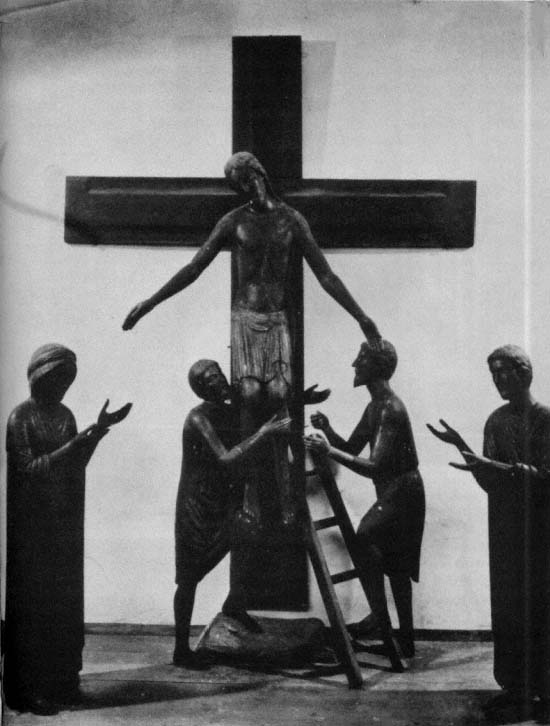
27.
Deposition, from Tivoli, see p. 265.
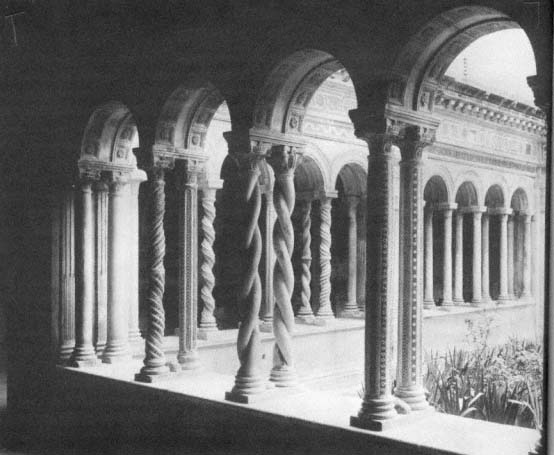
28.
Cloister of Saint Paul's outside the Walls, see p. 216.
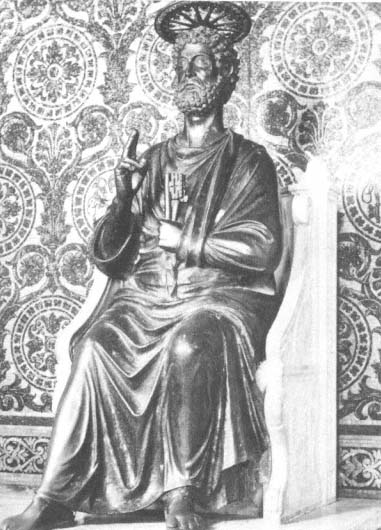
29.
Bronze Saint Peter within Saint Peter's in the Vatican, see p. 67.
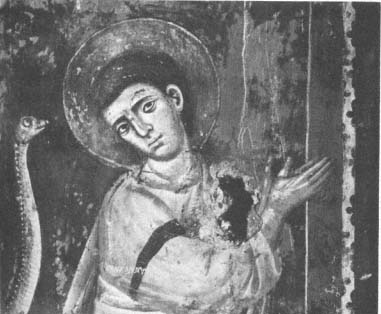
30.
Fresco from Moses cycle at Grottaferrata, see p. 278.
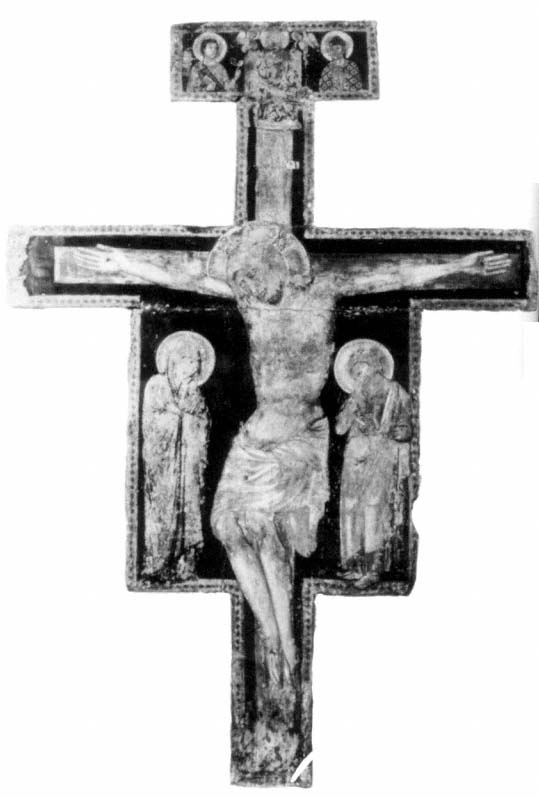
31.
The Cross of San Tommaso dei Cenci, from the Aracoeli,
now in the Palazzo Venezia, see p. 285.
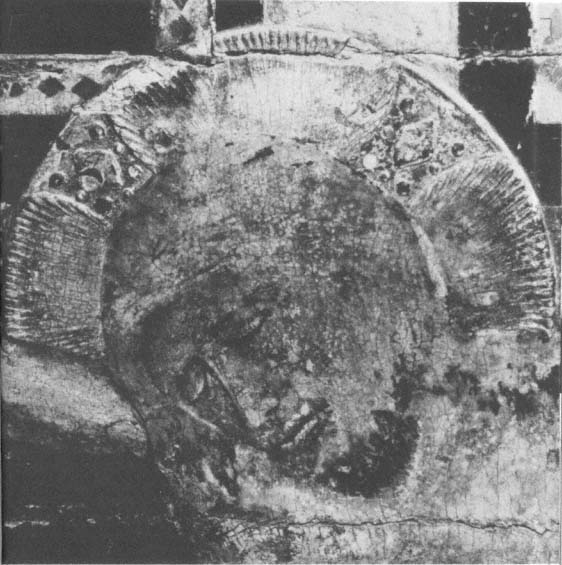
32.
Head of the Crucified Christ from the Cross of San Tommaso dei Cenci, see pp. 86 and 285.

33.
Grieving Virgin from the Cross of San
Tommaso dei Cenci, see p. 285.
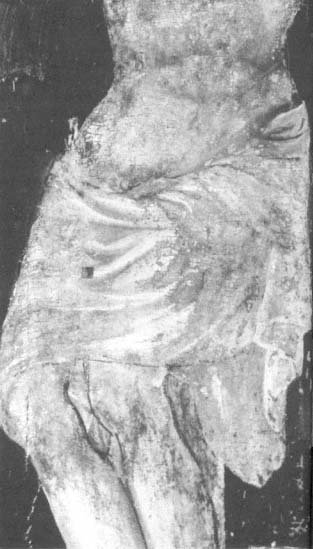
34.
Detail of the Cross of San Tommaso dei Cenci,
cloth, see p. 285.
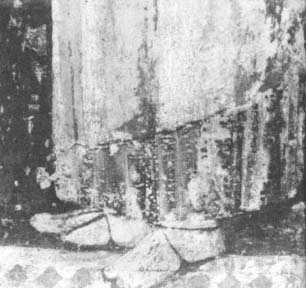
35.
Feet of Saint John, from the Cross of San Tommaso
dei Cenci, see p. 285.
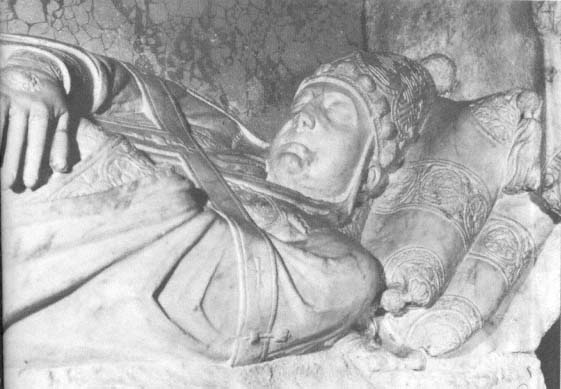
36.
Sepulchral figure of Honorius IV now in the Aracoeli, detail, see p. 68.

37.
Boniface VIII, recumbent, in the Grotte of Saint Peter's in the Vatican, see pp. 67–68, 269.
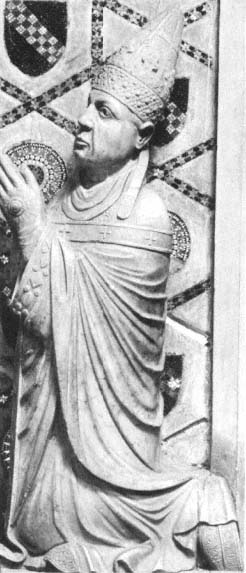
38.
Boniface VIII at the Lateran, see p. 162.
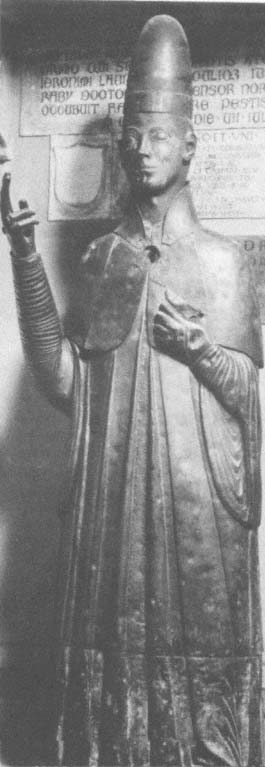
39.
Boniface VIII in the Museo Civico
at Bologna, see p. 162.
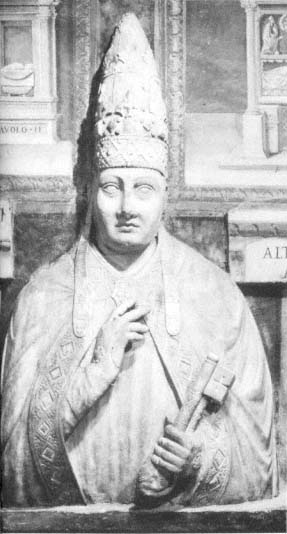
40.
Boniface VIII in the Grotte of Saint Peter's
in the Vatican, see p. 162.
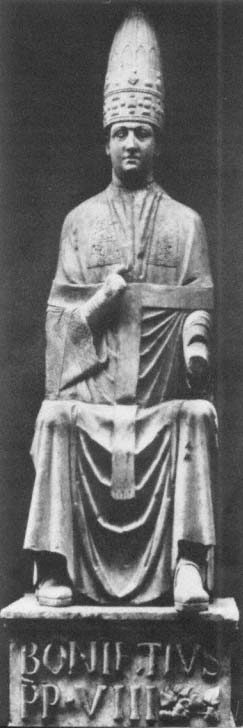
41.
Boniface VIII in the Museo del Duomo
at Florence, see p. 162.
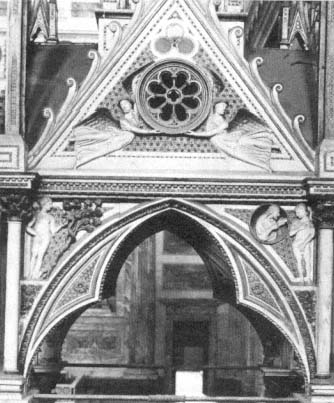
42.
Ciborium of Saint Paul's outside the Walls, Gothic cupola
with rose and Adam and Eve, see p. 216.

43.
Campanile of San Silvestro in Capite,
see pp. 27, 231, 247.
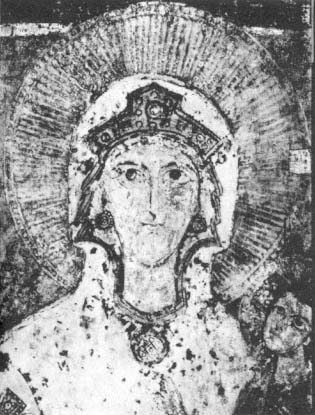
44.
Glorious Virgin of Sant' Angelo in Pescheria,
restored, detail, see pp. 44, 283.
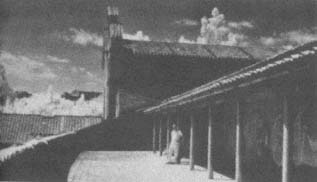
45.
Tre Fontane, series of frescos, second story,
facing fields, see p. 67.
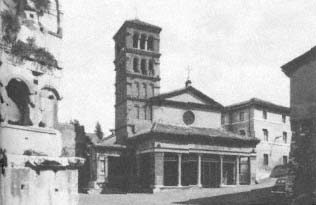
46.
San Giorgio in Velabro, see pp. 195–196.
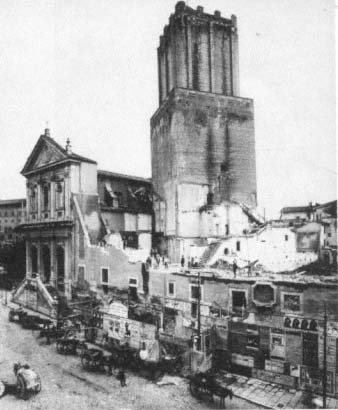
47.
Torre delle Milizie during restoration, see pp. 190, 200–201.
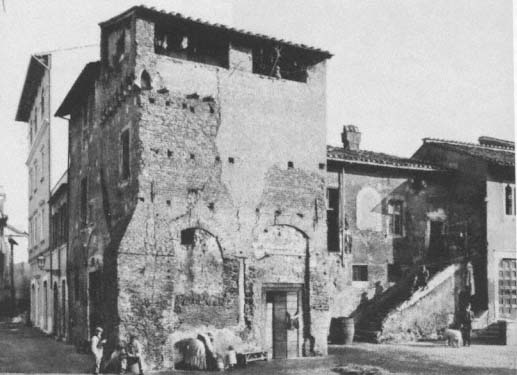
48.
Medieval House near Santa Cecilia in Trastevere, see p. 38.
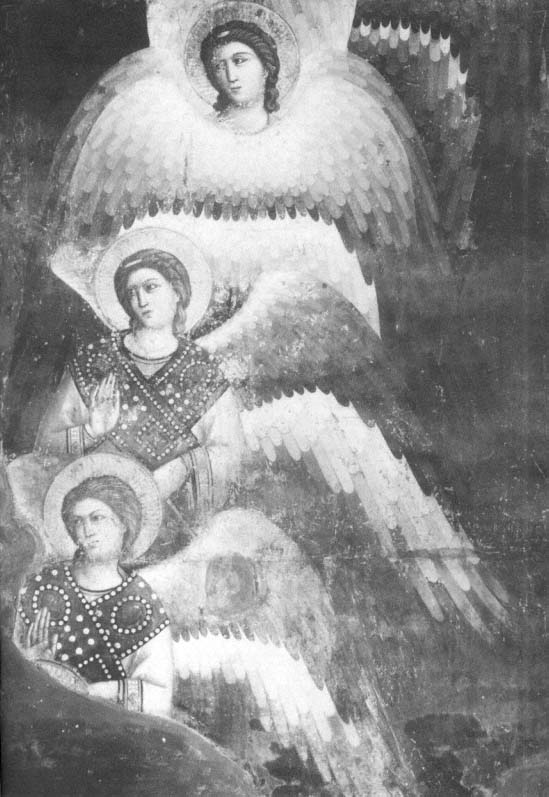
49.
Angels from the Last Judgment by Cavallini, fresco in Santa Cecilia in Trastevere, see p. 67.
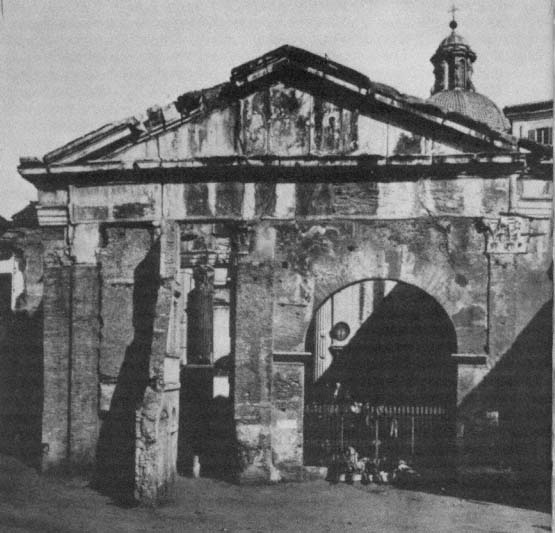
50.
Sant' Angelo in Pescheria during restoration, see pp. 39–46, 281–285.
On October 21, 1286, the noble lord Matteo Rosso Orsini (the son of the tyrant Matteo Rosso Orsini and himself senatorial vicar of Rome under Nicholas III) sat on a hill in Rome now called Monte Giordano (the Orsini hill, named for a Giordano Orsini, although in 1286 still called by its old name, Monte di Giovanni di Roncione, where by 1262 there was already an Orsini loggia as well as more formidable buildings) and sold tenements to his nephews.[25] They were tenements, some of them, bordering on those of Pandulfo Savelli and his nephew Luca. There were four Orsini nephews, Napoleone, Matteo, Orso, and Giovanni; they were sons of Rainaldo, Matteo Orso's brother and the founder of the Monterotondo branch of the family. The nephews paid 12,500 florins for the collection of holdings which they bought. The sale took place in the house where lodged the cardinal deacon of Sant'Eustachio, Giordano Orsini (in a personal family place some distance from Giordano's titular church). Giordano was, as the document says, Matteo Rosso's brother and the paternal uncle of the four nephews. The proceedings were watched by a little assembly of witnesses: the cardinal himself; the archdeacon of Messina; Master Giovanni of Zagarolo, the cardinal's chamberlain; Matteo of Naples, a papal auditor and chaplain; Master Angelo of Trastevere and two other members of the cardinal's household; a Fra Pantaleone of the city; a clerk, another witness, and one of those medical doctors (in this case, Giovanni di Pietro di Messer Luca) who seem to appear everywhere in large Roman households in this era of fear and fever.
In the scene on Monte Giordano a great Roman family assembles to do business. The business has to do with extensive tenements and lots of money, both of which are being kept within the larger family. The scene is both an example of family solidarity and of family fragmentation: an uncle as an individual sells to his nephews as a group. A cardinal uncle (as familiar a figure as the attendant physician, less widespread but infinitely more powerful and desirable) looks on as a presumably impartial but interested observer-arbiter. ("My uncle is a cardinal" is the device of strength in thirteenth-century Rome; "My uncle is the pope" is the device of victory.)
In 1300, in a scene strikingly similar to that on Monte Giordano, in the hospice of Cardinal Francesco Orsini, the cardinal presides over and witnesses the division of properties between his nephews. In document after document, groups of Orsini are seen dividing, acquiring, reassigning property, concerned in family property action.
The ordinariness of members of a family's acting together cannot be overstressed, but neither can the ordinariness of two or more com-
posite groups within a family's dealing with each other as they might with a group from another family. The point is made perfectly clear by an act of 1293 in which the sisters in a sibling group (Orsini neighbors rather than Orsini) sell a share of property next to a garden of San Salvatore in Campo, in the heart of Rome to their brothers. (And this act recalls the constantly observable ambiguity in the importance of women in family and city; they were exposed, consulted, valuable, active—but they were not really like men.) The complexity of intrafamily action, and something of its possible, occasional motivation, is suggested in 1262 when Orsini nephews alienate property to a cardinal uncle, "for benefits received or hoped to be received," and in 1267 when the nobleman, lord Napoleone di Matteo Rosso, citizen of Rome, with the consent of two brothers and two nephews, gives to his brother the cardinal, and future pope, Giangaetano, a fourth of Rocca Galeria, freely, not because of fear or threat, "not in consideration of his church or cardinalate, but because of the love and brotherhood he felt for him."[26]
The Orsini themselves are the success story of thirteenth-century Rome. They are, in a way, its composite Horatio Alger. (The qualification is due to the fact that they did not start from nothing—the Boboneschi Boboni were a Roman noble family—and to the fact that there is no implication of homely virtue in their story.) From the point of view of a Colonna sympathizer, the Orsini seem to have been single-minded. Their aim was the Lateran (or in their case the Vatican, the papal residence and church in their part of Rome) and the various profits it represented and brought. Occasionally, it should be noted, even by the least sympathetic observer, Orsini wavered from the straight and narrow path and cast covert glances at religious enthusiasm. Latino Malabranca, who generally seems, as a cousin and nephew, to have elevated the Orsini connection, is, for example, the cardinal whose inspired speech, according to Stefaneschi, suggested Peter Celestine as a candidate for the papacy as well as the legate, who, according to Salimbene, so disturbed the ladies of Bologna by restraining their fashion.[27] Like the families of tyrants elsewhere, the Orsini were involved with the Franciscans, and they were great patrons of the arts. Nicholas III, although very Orsini, was an essentially capable, beneficent, and serious pope. In general, however, the Orsini were distinguished by their straightforward aggressiveness, by their success, and by their clannishness.
The rise of the Orsini was due to the fact that Celestine III, the
Bobone uncle of the first actual generation of prominent Orsini, advanced them to power. He himself had been advanced by the great Alexander III. Celestine was, by the time of his papacy, old in importance (and perhaps virtue), and he had come from a family known in Rome. The family was forcefully pressed forward by Matteo Rosso, the "Guelf" dictator (the beast of the Septizonium). It was made both more powerful and more respectable by Matteo Rosso's nephew, Cardinal Matteo Rosso. This clerical Matteo Rosso (in what is thought to have been the fashion for pretentious young Roman nobles in midcentury) had gone to Paris for theology, and perhaps (in, again, what is thought to have been the fashion) to Bologna for law. Himself a theologian, brother of a theologian, connected with Aquinas, the scion of a house that favored Francis, chaplain to Innocent IV, cardinal, he can be made to sound very good; and he has been (as the hero of a short essay). Besides giving his family another vote in the sacred college, Cardinal Matteo Rosso gave it better tone—not perhaps so high as his brother's, but more directly pertinent and noticeably helpful.
But the triumph of the Orsini was sealed by the election in 1277 of Giangaetano Orsini, son of the tyrant Matteo Rosso, as Pope Nicholas III. Giangaetano's election crowned a long, ambitious, and respectable career—he had been a cardinal since 1244.[28] Nicholas III's favoring his family is, as is by now surely clear, one of the most familiar of late thirteenth-century Roman themes. The Franciscan chronicler Salimbene drew attention to it in talking of the cluster of four cardinals who were related to Nicholas. Salimbene did not really speak badly of three of them: Matteo Rosso, Giacomo Colonna, or the Dominican Latino Malabranca. Salimbene achieved his effect with the fourth, Giordano Orsini, the man on the hill:
The fourth cardinal among the pope's relatives was lord Giordano, the pope's brother, a man of little learning, rather like a layman. But because flesh and blood told, he made him cardinal. So he made those four cardinals from his own family (parentela ). So he built, as other Roman popes had, Sion on his own blood, of which Miceas III says, "who builds Sion on blood and Jerusalem on iniquity." I believe certainly on my conscience, I am persuaded, that there are a thousand friars minor of the Order of Saint Francis (of which order I am a minor and inferior friar) who are better suited to be raised to the cardinalate both by reason of their learning and their saintly lives, than many of those who by reason of their being related to the Roman pontiff are elevated.
And Dante has Nicholas III say in hell:
e veramente fui figliuol dell'or sa
cupido sì, per avanzar gli or satti . . .
[And I was truly a son of the bear
So anxious was I to advance the little bears . . .]
There is even a story, not very well authenticated, that Nicholas planned an Orsini kingdom in the north. He certainly used his relatives in governing the temporalities.[29]
The family brought to consolidated and obvious power during Nicholas's papacy was a family based in, and centered around, obvious geographical places. These places were not all in Rome. There were Orsini places in the campagna and in the Regno—and the Orsini grew into the great Vico estate around Lake Bracciano. But the Orsini places in Rome were very noticeable: the Theater of Pompey, the Campo dei Fiori, and the Piazza dei Satiri, Monte Giordano, Castel Sant'Angelo, the area around Saint Peter's—a strong (but not solid) band through the center of Rome. In talking of the Orsini's holding Boniface VIII their prisoner after Anagni, the chronicler Ferreto speaks of the complete way in which the Orsini controlled the area around Saint Peter's "with their buildings all around and close to the church in a place where they were really powerfully dominant." The church was in their district; it was their temple. Nicholas III glorified it, and he was carried from Soriano (which he had taken from the "heretic" Guastapane) to be buried in it. The Orsini consolidated their power over Saint Peter's in the early fourteenth century when the chapter was packed with members of the family and Cardinal Napoleone Orsini was its archpriest.[30]
In the Orsini, the machine of the great Roman family is exposed. In the thirteenth century it is the most efficient, and perhaps least charming, of the group of major families, but in many ways all of them are alike and have recognizable common characteristics and ways of behavior. The scene on Monte Giordano is a scene that, with a change of names, would have seemed natural in any of their similar seats. In his poetic celebration of the coronation of Boniface VIII at the end of the century, Stefaneschi identified a cluster of really great Roman families—those of the Roman nobles who press forward and lead the brilliant band of ritual merrymakers: the Orsini, the Colonna, the Savelli, the Stefaneschi, the Conti, the Annibaldi, and the Vico prefect of the city. The Stefaneschi, a Trastevere family like Innocent II's declined Papareschi, although noble and well connected, may have been men-
tioned rather than other families of similar pretensions—Normanni, Sant'Eustachio, Suburra, Papazurri, others—because the author was himself a Stefaneschi. But surely more than any of the other comparable families the Stefaneschi dominated a distinct area, that around Santa Maria in Trastevere; and as their patronage shows they were very rich. No other family's reputation is so concentratedly one of mecenatismo , of the lavish and informed patronage of the arts. The importance of Bertoldo Stefaneschi as a patron of real taste is apparent not only in the Cavallini apse mosaics in Santa Maria in Trastevere but also in Bertoldo's exquisite floor-tomb within the same church. Cardinal Jacopo Stefaneschi, the poet, is, however, the central figure in Stefaneschi patronage. His largesse was spread broadly but with discrimination, as one can see in his selection and description of Giotto, the artist who created the Stefaneschi altarpiece and "Navicella" for the Vatican. Jacopo was also a patron of illuminated manuscripts, including three manuscripts of his own works, of which one volume of his Opus Metricum contains a very elegant painting of the beginning of the procession from Saint Peter's at Boniface's coronation, the procession which allowed him to include the name Stefaneschi among those of the leading Roman nobles. One seems to be watching the very process of the Stefaneschi (already intermarried with the Orsini) buying and giving, writing and patronizing themselves into the highest charmed circle.
Over and over again, however, one must force oneself to realize that the circle was not a closed one; it was not isolated. The families in Stefaneschi's list were closely connected with lots of other families in lots of ways of which marriage is only the most obvious. Families in and out of the list cluster together in institutions like the Orsini's Saint Peter's where one finds Frangipane, Ponte, Annibaldi, Cenci, and a Suburra chaplain.[31] In any court, moreover, two families of great thirteenth-century importance must, moreover, be added to the Stefaneschi list: the popular, or relatively popular, Capocci, and, after the coronation, Boniface VIII's own Caetani—and, in addition, the fading Pierleoni, and the Frangipane, apparent in fascinating and, at least in its widow Giacomina (or Jacoba or Giacoma), sometimes splendid decay. Of all these families, two others ought to be looked at a little more closely, two nonpapal families whose pattern is centered boldly around the figure of a single man, the Annibaldi and the Capocci.
The Annibaldi had a more pretentious background than some of their thirteenth-century peers, but not one so pretentious as they in the Roman manner have claimed. Descended presumably not from the pretended great Carthaginian Hannibal but rather from a German
count named Annaldus or Anwaldus, they increased their importance with the marriage of Annibale Annibaldi to a daughter of a count of Tusculum in the later eleventh century. Their actual political importance in Rome rose, in large part it seems, from the marriage of Annibaldo senior to a sister of Innocent III (although the marriage must also have seemed advantageous to the Conti as they moved into Rome). The Annibaldi rose on the back of Conti greatness by strongly supporting, with Pandulfo of the Suburra, Riccardo Conti and the pope in their violent Roman disputes at the beginning of the thirteenth century.
As the Savelli physically replaced the declining Pierleoni, the Annibaldi replaced the Frangipane. By the early 1240s the Annibaldi had succeeded in getting Enrico and Giacomo Frangipane to grant them half of the Colosseum—a transaction connected with Frederick II's involvement with Roman tenures, monuments, and families. Innocent IV later quashed the grant, claiming the Colosseum as a papal fief. In the 1250s, nevertheless, the Annibaldi controlled the Colosseum; it was still their area of Rome in 1303 when Boniface VIII supposedly wanted to flee to them (or their neutrality) from his Orsini-Vatican captivity. Even now the tower of the Annibaldi points out that this was once their part of Rome. The Annibaldi also came to control the great Torre delle Milizie until at the turn of the century it was transferred to the Caetani (a family more successfully and permanently, although interruptedly, acquisitive). The Annibaldi towers controlled the roads that led toward their possessions in the country, in the campagna , and the Marittima. They were a town and country family with major "feudal" holdings. In this they were typical as they were in their rise from relative obscurity through a familial connection with the papacy.[32] And one ought not in thirteenth-century Rome to lose a sense of a surrounding, in many ways conventional, "feudal" world, in which Vico, Frangipane, Conti, Colonna, Orsini, Caetani play other, seignorial and feudal, games.
The Annibaldi were also typical in breaking, in the thirteenth century, into branches. The Annibaldi de Urbe became the Annibaldi de Coliseo and the Annibaldi de Militiis. They, again typically, were divided between opposing parties, "Guelfs" and "Ghibellines"—perhaps a kind of family insurance, perhaps in extension of family dispute. Typically, too, members of the family held important positions in both the Roman church and the Roman state. Annibaldo senior was senator in 1221 and again in 1231 (and it is he who is thought, with Gregory IX, to have been responsible for a sordid secular inquisition
against heretics). This Annibaldo was probably the father of Cardinal Riccardo Annibaldi, the repeated Annibaldi candidate for the papacy and a great building member of his family.[33]
Riccardo Annibaldi was by blood as much Conti as Annibaldi; Innocent III was his uncle. In 1238 Riccardo was created cardinal deacon of Sant'Angelo in Pescheria by his relative Gregory IX to replace a cardinal who had been promoted to the see of Porto, and when Riccardo died, toward the end of 1276, he was still cardinal deacon of Sant'Angelo. From 1240 to 1248 Riccardo was papal rector of Campagna and Marittima, an important shrieval job. He was in general charge of a large area of papal territory with fiscal, military, and judicial responsibilities. He adjudicated problems, as in the case of one town's (Piperno's) trying to build an aqueduct in another's (Terracina's) territory. He mobilized one town (Terracina) to capture back a castle from another (Setino). He settled a dispute between the nobles and commons of another town (Anagni), and demanded that a further town (Alatri) keep peace with another (Ferentino). These jobs were important, difficult (particularly in Gregory IX's reign), and potentially at least, very profitable. (The sort of profit that might be reaped is suggested by, for example, the determination of the council of Perugia in 1276 to offer to its hoped "defenders" at the papal court, six cardinals, eight hundred florins apiece to help Perugia in a dispute with Gubbio; of the cardinals suggested, two were Savelli, one Orsini, one Fieschi, and one was Riccardo.)
When Gregory IX's successor, Innocent IV, went north to Lyons in 1244, he left a triumvirate of ruling cardinals in Italy; one was Riccardo. After 1249, when the dynamic young cardinal Pietro Capocci took over real control of papal Italian government, Riccardo was made vicar of the city of Rome; and the vicariate, with its considerable local powers, particularly in arranging the settlements of disputes, could be a profitable office for any holder who wanted to make it so. Riccardo was also then much involved with the "English party" (perhaps because of earlier contacts with the English court) in the advancement of Richard of Cornwall to the throne of Sicily through the senatorship of Rome; this proved profitable to his family in English livings and probably to the religious order he protected in houses.[34]
Under Alexander IV, Innocent's successor, and, like Innocent III and Gregory IX, a Conti relative, Riccardo was at full strength politicall (although he may have been malarial), and he remained politically strong under Alexander's French successor.[35] From Alexander, Riccardo received the office of archpriest of Saint Peter's Basilica, a
church which had a profitable trail of dependents: forty-four churches, fourteen hospitals, two monasteries, and twelve castles. Over all this the archpriest ruled with a relatively free hand. He dispensed the livings (although propriety as least would demand consultation with the canons). Riccardo seems to have been insufficiently discreet in appropriating the funds of the basilica. Successive popes tried to preserve appropriate amounts of the income of the church for the upkeep of the basilica itself: Alexander IV asked that a fourth be so used; under Urban IV, in 1263, the church's accounts were destroyed or lost, and in 1267 Clement IV was complaining about the use of the basilica's income.
In the early 1260s the French pope Urban IV decided to enlarge the college of cardinals. He appointed fourteen new cardinals, balancing two new Orsini against two new Annibaldi. In these appointments he recognized the central familial dispute in Rome in his period. He also created a strong literally Annibaldi node of cardinals in the curia—and the nephews accepted the position of being their uncle's followers. Meanwhile, having given up the hopeless English cause, Riccardo had become a central figure in the fight for Angevin supremacy, a policy of initial success. Riccardo had become a very political cardinal.
It is possible to find in Riccardo, as his biographer has, consistent principles—specifically, support of the freedom of Rome and of the Holy See. But these are principles that evidently allow much freedom of action—sufficient certainly to anger the actual holder of the Holy See, as they did Clement IV. They are also principles under which one can support one's family. Riccardo's strong opposition to Brancaleone might seem more disinterested if Brancaleone had not been replaced by Emanuele da Brescia, a man who was too much an Annibaldi tool to survive in the senatorship. The Annibaldi faction had about it a peculiar "aristocratic" and "clerical" quality that is hard to define and is best seen perhaps in its opposition to Brancaleone, for which the support of certain concepts of "freedom," particularly class and ecclesiastical freedom, seem a natural and pleasing face, or explanation. Riccardo's principles, in other words, do not seem too secure. (His switch to the Angevin party is notorious.) His family's principles were, of course, less secure than his own: Riccardo received as a specially courteous present from Charles of Anjou the life of a nephew who had followed Corradino to his defeat—that he might not die as had two other nephews, who had been hanged by Brancaleone upon his recovery of power.
The central theme of Annibaldi policy was its war with the Orsini. In conclave after conclave Giangaetano Orsini and Riccardo Annibaldi are thought to have kept each other from becoming pope. Repeatedly they were chosen electors to select the new pope. In the end Giangaetano won because Riccardo died first. Under Giangaetano, as Nicholas III, the Orsini got what the Annibaldi had tried to get; but the Annibaldi were not completely crushed. After Nicholas's death the Annibaldi instigated a rebellion against the Orsini in Viterbo and the patrimony, and Orsini holdings were raided, and Orsini cardinals were captured. When at the Sicilian Vespers the wheel of fortune turned for families all over Italy, and the French eventually died on the Roman Capitol (and four years after the Vespers Cardinal Ancher, Urban IV's favored and hated nephew—son some said—seems to have been murdered in his church of Santa Prassede), the Orsini rose again. Eventually, within the year 1284, the Orsini made peace with the then "penitent" Annibaldi (but not with the town Viterbo, which had implemented Annibaldi policy). By then the Orsini were changing their antipathies to other familial centers of rising strength. In fact one of Riccardo's nieces married an Orsini, although the two families were certainly not considered allies by the time of Boniface VIII's death.[36]
In the end Riccardo Annibaldi had failed to win the papacy and thus to carry his family to the pinnacle of Roman power. He had, however, over many years increased its prominence, its riches, and its power. He is an example of how a cardinal could help his kin. He made them the acquaintances not only of popes, but of kings and saints. In the period of Angevin-Annibaldi friendship there were banquets and receptions, royal entertainments at an Annibaldi country house—the same house at which Riccardo entertained Thomas Aquinas; Riccardo could play the intellectual host with Thomas and the gallant host with Charles. But particularly, in the great years, there was land and money.[37] In explaining Riccardo's influence, his biographer has said that it was due to his potent personality, to his constancy and his experience over a long period of time, but also to the "great personal riches that he had accumulated."[38] The riches were enhanced by a number of podestàships: Riccardo was podestà of Velletri in 1270; his family ruled in Terracina, Alatri, Todi, Viterbo. The riches were connected, perhaps primarily, with investment in land and associated rents, tenements, fortifications, and men. In 1271, for example, Riccardo, in what comes to seem a rather characteristic thirteenth-century sort of deal, with the Conti-Poli affair in mind, got Rocca di
Papa from the poor Frangipane. Frangipane heirs had pledged Rocca di Papa as a surety for a loan of 6,500 lire . The Frangipane lost their surety and the Annibaldi fortified the Rocca.
More than twenty years after Riccardo's death, when the money (perhaps 200,000 florins) was collected for the great Caetani purchase of Annibaldi properties, including Sermoneta and country around Ninfa, eighty salme of gold and silver and brass, it was said, were carried for it through the countryside on a train of mules and horses—mules and horses not safe, however, from armed (Colonna) attack.[39] The eighty salme of precious metals should be seen as a century's accomplishment, what a shrewd, hard-working cardinal deacon could help his family achieve. The gold is also a token of the family's defeat, after death had defeated their cardinal leader. It stood for the triumph of the Caetani over the Annibaldi, the reduction of the Annibaldi, as in the case of the Torre delle Milizie, to a more purely financial power, less an armed, territorial power, at a time when arms could still be important against gold, as, ironically, the colonna attack clearly showed. But the Annibaldi achievement, the gold which was carried on the mules and the horses, was not presented to themselves or their contemporaries completely unaccompanied by some connection with what is more conventionally considered religion. The Annibaldi did not produce, as the Colonna did, a saint, but they did have a religious order (and a scholar).
Riccardo Annibaldi, more than anyone else, formed the Augustinian Hermits into the order they became. It was, in a way, his order until his death. Although he was very helpful to it, he was sometimes heavy-handed in dealing with it. In 1244 he became corrector of the Tuscan Hermits. In the years between 1244 and 1256 he collected his Hermits and similar fragmentary and half-formed orders into the order of Augustinian Hermits—brought their ecstatic indiscipline and enthusiasm into a conventional pattern—and got for them a Roman seat in the church of Santa Maria del Popolo. From 1257 until his death he was their Cardinal Protector. He was to the Augustinians something of what the Orsini were to the more conventional wing of the Franciscans. A difference lay in the fact that although his order was less brilliant and powerful than theirs, he controlled it more completely—he was Ugolino and Orsini combined. But although Riccardo's connection with his order was more personal than the Orsini connection, it does not seem to have been a bond of spiritual sympathy of the sort that tied the Colonna to the less conventional wing of the Franciscans. Among the chaplains within Riccardo's richly diverse
household there seems to have been no Augustinian Hermit (although there was a Capocci).[40] If, however, every great Roman collection of wealth, land, and blood needed, in order for it to become a really significant Roman family, a talisman of religion, the talisman the Annibaldi held was the order of Hermits.
Pietro Capocci, cardinal deacon of San Giorgio in Velabro, brought his family (or was instrumental in bringing it) another sort of religious talisman. The Capocci talisman was a miracle. During the night of September 26, 1256, it was later said, the horses in the Capocci stables, behind what is now the gallery of the Piazza Colonna, were noisily restless. Their grooms, who went to see what was bothering them, found that the well from which the horses were watered was overflowing. On its surface floated, unnaturally, a tile or slate, and on the slate was a painting of the Madonna. The grooms were unable to snatch the painting from the water. They called the cardinal. The cardinal prayed and retrieved the painting. It was immediately much revered; but the incident was investigated thoroughly by Pope Alexander IV before he permitted the formal veneration of the image. Alexander approved the miracle, and Pietro Capocci built a chapel in which the painting might be kept and honored. All this is legend, but legend that winds its way around historical fact. The legend's truth seems undoubted by the pious faithful who still crowd around to drink little glasses of water from the sacred well in the miraculous Madonna's chapel in the church of Santa Maria in Via.
The miracle was not Pietro's only method (if in fact it was his) of making more ecclesiastically respectable and attractive, at its end, an aggressively secular cardinal's career, and one that moved out of a recently antipapal and "popular" family. Pietro is remembered in his own church of San Giorgio as well as in Santa Maria in Via. There Pietro was one of a group of thirteenth-century patrons. On the architrave of the porch the rebuilding of "Stephanus ex Stella" is still celebrated in monumental thirteenth-century letters. Inside the church the munificence of Jacopo Stefaneschi is recalled in the damaged but still existing Cavallini frescos of the apse. To the altar's right, on an inscribed stone dated 1259, after the Roman manner of putting the details of gifts and holdings in stone (as on the wall of San Nicola in Carcere), is the record of Pietro's inalienable legacy to the church of land next to its tower (called "Advallaran" or in a place called "Vallaran," that is, the Vallaranum) and of the chapter's oath on May 20 always to celebrate Pietro's anniversary. Pietro's memorial concludes, before its final date, with the injunction: "Whoever reads this pray for
him." Beneath it another stone tells that in 1621 Vincenzo Capocci of the cardinal's same gens had the stone placed in a safer and more honorable place to protect it from the ravages of time. Pietro was a patron elsewhere. He founded a hospital, Sant'Andrea (Sant'Antonio Abbate), near Santa Maria Maggiore, where the contemporary inscription of his cardinal executors remains above the door of what is now the church of the Russian college; and he was a patron of Santa Prassede and Santi Silvestro and Martino (San Martino ai Monti)—churches in the Capocci part of Rome.[41]
The Capocci, like the Annibaldi, were deeply involved in the Conti disputes at the beginning of the century. Cardinal Pietro's father, Giovanni, was a leader in the violent attacks upon Riccardo Conti and Innocent III's other adherents, perhaps because some of them (Riccardo, Pandulfo of the Suburra, even the Annibaldi) were contenders for power in parts of Rome close to the Capocci's own. Although the Capocci had outlying possessions, as in the Trevi and Colonna near Santa Maria in Via, the center of their holdings was an area stretching from the Suburra to the Biberatica, between Santa Maria Maggiore and the Forum, the area of the towers that still bear their name, and of Santa Prassede and San Martino with the towers at the Santa Maria Maggiore edge of their area. Capocci patronage spread to chapels in Santa Maria Maggiore (where Pietro was buried in the Capocci chapel of Santa Barbara) and Santi Apostoli. A Fra Pietro Capocci is remembered in the book of anniversaries of Santo Spirito in Sassia.[42] By the end of the thirteenth century Capocci holdings spread out along the Salaria, the Nomentana, and the Tiburtina. Giovanni Capocci himself was twice podestà of Perugia—Capocci fame spread even farther than their Roman holdings. The Capocci were allied through marriage with the Savelli and Colonna and, by the end of the century, with the Orsini. Pietro's brother Ottone was, like Pietro, favored by Innocent IV Fieschi.
In 1267, as captain of the people (and the tale recalls the recurring popular tone of the Capocci, their not being a "noble" family), Angelo Capocci was able to lead the commune against the "Guelf" forces, to recall the policies of Giovanni Capocci less violently but more effectively. The strength of his family's position had been increased by the family investment in clerical careers, those of Ottone and especially Pietro. Pietro's relatively early death, in 1259 when he himself was about fifty-nine, kept him from being, as he might have been, the sort of constant contender for the papacy that Riccardo Annibaldi and Giangaetano Orsini were. As in the case of the Annibaldi,
but not the Orsini, the Capocci gains from having in their house a powerful cardinal were not extended and solidified by their also having a pope.
The actual career of Pietro Capocci, favored by his Savelli relative Honorius III and advanced by his friend Innocent IV, was, in spite of its clerical name, remarkably secular. Pietro was the bright young man who was promoted to the sacred college in 1244 by Innocent IV and in 1249 replaced the triumvirate of cardinals (including Riccardo Annibaldi) then ruling papal Italy. As early as 1231 Pietro had acted as a papal military commander; and in his own period of secular ascendancy, from 1249 to 1251, his main job (the focus of his general rule) was to organize the papal effort at military invasion and conquest of the Regno. Apart from his use in military affairs, Pietro was used particularly as a legate—an office that demanded a very general sort of competence. Competent, efficient if not successful, a dispassionate official, he seems to have been; there is nothing to indicate that there was anything particularly religious or ecclesiastical about him beyond the area of his service, the office of his superior. His position, though, in Savelli and Fieschi confidences undoubtedly allowed him to retrieve the losses (at least in reputation) of his father's opposition to the Conti. He, like the Orsini cardinals and Riccardo Annibaldi, was one of those important counters or chessmen who moved their families' positions forward in the thirteenth century—without dissipating their augmented properties among (at least known and legitimate) progeny. Pietro did, however, disperse some reasonably large part of his property in ecclesiastical bequests, a sort of conspicuous consumption (or lack of consumption), which added to the status and thus, in various ways (like marriageability, potential leadership), to the power of the family.
Abundant physical evidence of family self-consciousness remains from the later thirteenth century. Family arms (stemme ) decorate and identify walls and tombs and, in records, cloth. Stefaneschi stemme proclaim family importance in Santa Maria in Trastevere, Caetani in Santa Maria in Cosmedin, Savelli in Santa Maria in Aracoeli; and in the warehouse of the Vatican treasury lay two pieces of red Lucchese cloth decorated with griffins and the Savelli arms.[43] But, in spite of this clearly expressed self-consciousness, it must repeatedly be emphasized that it is artificial to separate sharply any small band of Roman families (like, again, that of Stefaneschi's list, slightly augmented, or of Saba Malaspina's list of leading "Guelf" and "Ghibelline" nobles) from their neighbors who were only slightly less rich or prominent or powerful. If there was, in the thirteenth century, any clear institutional
division beyond that of offices actually held (and perhaps set positions at formal occasions, in processions), between one group of families and the rest, it has been well hidden (except for the occasional use of honorific titles: proconsul, magnificus, baro, miles ) from our eyes. What evidence remains is ambiguous, like stefaneschi himself, with his great nobles pressing forward from the throng of the procession which passed other noble houses, or like the antimagnate legislation of 1305, which specifies the opposed families presumably because a caste name was insufficient. The mid-fourteenth century statutes, on the other hand, talk of recognizable classes of commoners, knights, and barons or magnates, recognizable enough for graduated fines; and they suggest particularly clearly an expected horsed, game-playing, office-holding caste. Still the central point is clear enough: the class structure of Rome in the thirteenth century, particularly in its upper reaches, was still in a dynamic stage and was flexible and responsive. Any family which got for itself a cardinal, or of course a pope, could move with its new wealth and power to a position as elevated as its local and provincial properties could sustain.
The closeness of other families to those which have been treated here as of the first magnitude (with whom they married) is quickly illustrated by the family of Pandulfo of the Suburra. The importance and wealth of Pandulfo at the beginning of the century is made perfectly clear by his position and that of his properties in the Conti disputes. Pandulfo's senatorial eminence and his role of connecting the Conti with the city were the official and active expressions of his towered wealth so important both to attack and to defend. At the end of the century Pandulfo's descendant Filippo di Matteo di Pandulfo de Suburra was still very rich. In his will of 1301 he left five hundred florins (from the two thousand florins to be gotten from houses for specific legacies) to the paupers of the hospital of San Matteo on the Merulana.[44] In June 1270, when, as a plaque in the Pantheon portico proclaims, a new bell tower was erected there, Filippo's relative, another Pandulfo de Suburra, was archpriest of Santa Maria Rotunda, the Pantheon—and in the same decade a daughter of Pandulfo de Suburra was abbess of San Cosimato in Trastevere.[45] If the Pantheon's Pandulfo had been moved from archpriest to cardinal priest of a Roman titulus, the name of the Suburra would almost surely have joined those in Stefaneschi's list. Of course cardinalates were not accidental gifts; the Suburra position in the 1270s may well not have been strong enough to demand elevation. If it was strong enough to suggest elevation, if some surface accident of appointment had brought eleva-
tion, with reasonable luck and ability Pandulfo might have done again for his family what Riccardo Annibaldi and Pietro Capocci did for theirs.
Among those magnates proscribed in 1305 were the family of Oddone of Sant'Eustachio, a family prominent in the twelfth century and still, in the thirteenth century, clustered around the Roman church which presumably gave it its name (although a family hard to distinguish definitively from other people who are spoken of as coming from its area of Rome, of Sant'Eustachio). The Sant'Eustachio can be seen in 1279 involved in arranging, selling, and thus dividing a major inheritance. Oddone di Angelo de Sant'Eustachio is seen selling for ten thousand lire to his brother Paolo his share of a number of holdings including those he held together with his brothers, Paolo and Matteo. (This Matteo is just possibly the Franciscan priest Matteo de Sant'Eustachio who appears in friar's habit on an incised floor tomb now on the wall of the north aisle of the Aracoeli.)
The inheritance was various. There were holdings out beyond the Milvian bridge, next to a place called "Three Columns," and a number of houses in the center of town in the rioni Sant'Eustachio and Santa Maria in Aquiro. These latter included: half the house in which Matteo lived, with half its cupola and arch, adjoining land of Sant'Eustachio, and with public roads on two of its sides; half the house in which Oddone lived (like Matteo in the rione San'Eustachio) again with roads on two sides; a great house with tower and arch in the rione Santa Maria in Aquiro bounded by a road, the wall of the Pantheon, and the property of Compagio di Giovanni Lucidi; another house inhabited by the shoemaker Thomaraccio di Giacomo (or possibly a man named Calzolario) with the public road on one side, the portico of the Pantheon on another, and the Via di Portico (the Via di Rotondo). The Sant'Eustachio had half a palazzo and a number of other half houses twisting around the property of their neighbors, like Oddone Bruno the notary, and their tenants, like Angelo di Pietro di Stefano, and around the Pantheon and Sant'Eustachio, in the center of Rome.[46] They were an old family, rich, and in the early fourteenth century they could still seem dangerous. The Sant'Eustachio have been paired with the Normanni in twelfth-century position, and the Normanni appear with them in the list of 1305.
The family di Giudice, "de Iudice," was an imposing and senatorial one, important around Sant'Angelo in Pescheria and elsewhere, which, related to the Orsini, attached itself through marriage to the Conti and eventually to the Frangipane. Another family, the Parenzi,
has a peculiar distinction. The Pietro di Parenzio who was senator in 1245 was the great-grandson of Saint Pietro di Parenzio, the podestà of Orvieto murdered there by heretics on May 21, 1199 (an event which he and Innocent III had half-predicted amid the tears of Pietro's wife and mother)—a nice orthodox saintly-governmental line.[47]
An extensive Roman nobility proclaimed the pope as he rode under their arches from the Vatican to the Lateran on his coronation day, as he passed their palaces, their complexes of houses and towers. Propertied families sat entrenched, as presumably did the Massimi in their immemorial place, although this was one of their dormant centuries. The Margana seem already to be beginning to gather around the area of their tower under the Capitol near the market, the Cenci were in the Giudia. Around them move the almost ghostly but still elegant declining Frangipane, with their exquisite Greek connection: the marriage to an imperial Comnena at Veroli in 1170; the name of the Magnifico Saba Frangipane in the Rocca di Papa sale of 1272; the bequests of Giovanni Frangipane to the monks of San Saba and Grottaferrata before 1266; it is even conceivable that Saint Francis seemed "Greek" to the eyes of this family of the Septizonium—perhaps Francis's friend Giacomina, widow of a Frangipane of the Septizonium, recognized in Francis a return to Anthony Abbot—perhaps Frederick II looked "Greek" to them, both as a rejection of currently dominant Roman power and wealth and as hope for change.[48]
The thirteenth-century Frangipane, although they survived and would continue to survive indefinitely, always bring to mind the mutability of Roman family fortunes, their rise and fall. A number of specific tenements follow the rise and fall of individual families. San Felice Circeo (where Circe sang) on the coast south of Rome, on the point between Terracina and what is now Sabaudia, was in the hands of the Frangipane in the twelfth century. At the beginning of the thirteenth century Innocent III gave it to his Annibaldi connections. After a mixed century, during which it was sometimes in Templar hands, it was sold in November 1301. Riccardo de Militiis degli Annibaldi sold San Felice and its appurtenances to Pietro II Caetani (the pope's nephew, the really aggressive figure in building the Caetani empire) for twenty thousand florins.[49] To that date, 1301, the names Frangipane, Conti-Annibaldi, Caetani represent two centuries' turn of the wheel of fortune.
The name of this Riccardo's branch of the Annibaldi, "of the Torre delle Milizie," recalls a similar pattern. Built on antique foundations in its present form under Gregory IX (a Conti), the torre seems to
be on or near the site of fortifications of Pandulfo of the Suburra, a Conti supporter, and to have been later in the hands of partisans of Pandulfo. By 1296 it was held by Riccardo Annibaldi; within a few years it was bought by Pietro Caetani. Pietro's purchase of some of the area surrounding it is interestingly recorded. In April 1301 Simone "de Tarquinio," the inquisitor at the Franciscan house at the Aracoeli on the Capitol, in the presence of his associate Fra Gionata "de Tarquinio," sold to Pietro's proctor, for one thousand florins of gold, the possessions of Federicozzo da Roma, in the rione Biberatica, in the contrada Milizie, next to the houses of the Milizie itself which had formerly been possessions of riccardo de Militiis (that is, Annibaldi), by the Via "Silicis," by the road from San Basilio (in the house of the Knights of Rhodes) to the Milizie in front of San Salvatore de Divitiis. Federicozzo's property was in Simone's hands because it had been confiscated by the inquisitor Alamanno da Bagnoregio because of Federicozzo's aid to "the schismatic Colonna." Simone's proctor, Crescenzo di Don Angelo Silvestri de Archionibus, actually took Pietro's proctor, Guido di Don Pietro da Orvieto, a knight, down to the property for Crescenzo to induct Guido. Crescenzo seized Guido's right hand and they perambulated the place. Guido went into the houses, buildings, and things sold. He walked through them. He picked up pieces of sod. He touched the stones that were there. And as he walked and picked and touched, Guido said that he wanted to take possession of these things for Pietro—the formalities of taking seisin occurred, the formulaic act was enacted, as these two men and their witnesses (Franciscans, a knight from Orvieto, a banker from Viterbo, the great notary Nicola Novello da Vico) wandered through the ruins of, or by, the Market of Trajan.[50] As the Torre delle Milizie moved so did the Theater of Marcellus, in this case from Pierleoni to Savelli, and so too did the Colosseum, from Frangipane to Annibaldi. These places witness the change of family names, names standing for different eras, but seeking their stability, seeking to anchor their prominence (and to protect the roads which led to their profit-making possessions) in the same sorts of property as their predecessors, in the same stones at the same places (and once, it will be remembered, in the affair Poli-Conti, the same name).
The wheel of fortune was often very quick in its turning. In 1301 Boniface VIII and Pietro Caetani seemed to be carrying all before them. In February 1304, understandably, Pietro was retrenching. He was then selling half a castle south of Rome for thirty thousand florins; and he was selling it to Pietro Frangipane.[51] The replacement of one fam-
ily by another, however, does not seem necessarily to have implied any lasting enmity between them. In April 1310, in a Savelli fortress in the country, when that Magnificus vir dominus Johannes de Sabello Romanus proconsul sold properties to Donna Agnese, who was abbess of the Augustinian nunnery of Santa Maria della Rotonda in Albano, his first witness, a man pretty clearly present to visit him, was that noble Roman Uguicione di Don Sisto Pierleoni.[52] The Pierleoni and Savelli could obviously sit down together—as the Orsini and Colonna could rule together.
Something of the structure of the great Roman family has been revealed, one hopes, through the description of a number of individual families. First of all, the great families of thirteenth-century Rome were all rich. Their riches came from urban and rural land (and other real property) and office and the ability to supply armed men. Each source supplemented the others, helped the base of the other sources of wealth to grow. These families were all either Roman families who moved out to gain possessions in the country surrounding Rome or provincial seignorial and "feudal" families who moved into the city and added to their holdings a Roman base, although the movement is seldom clearly and visibly in a single direction.
Each family had a base in, and dominated, a section or sections of Rome: as the Savelli did the stretch of land from the Theater of Marcellus to Santa Sabina; the Orsini that stretch from Saint Peter's to the Campo dei Fiori, the Theater of Pompey, and the Giudia; the Colonna from the Mausoleum of Augustus to the Dodici Apostoli end of the Quirinal. Each family had consolidated holdings, and scattered ones, in the surrounding country: so the Orsini swamped the area around Viterbo and Bracciano; the Colonna around Palestrina; the Annibaldi around Rocca di Papa, Molara, and Campagnano; the Savelli in the regions around Palombara, Albano, and Ariccia.
The family's city fortifications not only provided it with a place for actual confrontation with its enemies, and security from them, but also guarded the roads that led to its country properties. The country properties could provide, and their money buy, troops; the men in the country could be attached to their lords in a much more conventional "feudal" way than the minor urban members of their faction were. Money, not arms, seems to rule thirteenth-century Rome; but the residual importance of arms is clearly visible at the end of the century, and the Annibaldi's exchange of land and fortresses for money is again, I think, a clear sign of their decline. The sort of income that Roman country properties actually provided in the thirteenth century can be
studied and understood in detail in the miscellany of various families' documents preserved in the Caetani archives (and extensively edited). One can see exactly what it meant, for example, to be lord of San Vito in the year 1292, to know what the lord was owed by each of his local tenants, and by them all together.[53] This knowledge defines the term "lord of San Vito"—and on a larger scale the definition of any family's holdings defines, in one very major way, itself.
The great families were families of office. Office made them great, and office—potent like the senatorship, the cardinalate, the papacy, or honorific like the proconsulship, the prefecture, the "chancellorship"—was the natural formal expression of their greatness. Some of their sons and daughters were cut off from marriage, the boys sent like nineteenth-century New Englanders off to the China trade (at least like Robert Acton in The Europeans ) in their time of mating, sent to the church to gather its treasure and build their houses and fill their churches with the equivalent of chinoiserie and with money. The girls were often sent into convents, sometimes neighborhood convents or faction ones, respectable havens from expensive marriages (when their marriages were not needed) and wastefully disparate descendants (where descendants were not needed). One sees, for example, at the Dominican house of San Sisto in 1331, a collection of Roman noblewomen, remnants of great thirteenth-century houses: a Colonna, two Pierleoni, a de Giudice and her daughter, and three Annibaldi (in an Annibaldi neighborhood and not in the Annibaldi's Augustinian order—but the Annibaldi had had Dominican connections at least since the time of their Dominican scholar Annibaldo in the mid-thirteenth century).[54] The Roman career in ecclesiastical office which brought the family profit is fully illustrated by Riccardo Annibaldi's career. The full, great dignity of office—the expression of the Roman family's doing what is was in a way designed to do, remembering a great Roman past—is finely illustrated by the Savelli pope and the Savelli senator ruling together. Their position could only have been enhanced by a great abbess at their side.
Refraining from marriage could help the family, but so could marriage. Marriage was one of the businesses of the Roman family; and every Roman family showed that it knew the value of marriage. Wealth and prominence were presumably always desirable in a spouse—they are what Margherita Colonna rejected in rejecting marriage. All the great Roman families married other great Roman families. The Caetani, rising to power, married both Conti (once from their own town, Anagni) and Orsini. The Savelli married the Orsini;
the Annibaldi the Conti; the Capocci the Savelli. The great families were related to one another in a great skein of intermarriage. Sometimes prominent Romans saved the name of mother or grandmother in their own names: so Stefania Rubea, or Rossa, is echoed in many Matteo Rossos in the Orsini family. Romans, however, did not marry only their own, as the heated quest for Margherita Aldobrandesca's inheritance makes clear.[55] The names of many husbands and wives are unknown; theoretically each may have been anyone (and one must always remember that there was no caste rule about marriage). But there is actually nothing to suggest that Romans married at all erratically. Marriage, like office and land, was a road to increased wealth, prominence, and respectability; and it was taken seriously.
The seriousness of marriage and its close connection with property is stressed, in a 1274 document recalling acts of 1248, by the involvement of notable witnesses (Normanni, Frangipane, Surdi, Annibaldi, probably Suburra) and distinguished senators (Pietro Annibaldi and Angelo Malabranca) in the arrangements and effects of a dower settlement made between Giacomo di Napoleone Orsini and Matteo Annibaldi for the marriage of Giacomo's son Fortebraccio and Matteo's daughter Golitia—an important attempt at alliance. And it is stressed in a more specific way by Martin IV (or his chancery or its petitioners) in a papal dispensation for a marriage between an Annibaldi and a Conti (Giovanni and Perna) who were too closely related to marry freely. Martin granted the dispensation, he said, because he believed that if these houses (domus ) were joined by a blending of blood it would be advantageous in many ways (multipliciter ) to both houses and to the factions surrounding them (ac partibus circumvicinis )—an interesting eruption of party into the papal register.[56]
Increased respectability (and possibility of office) was also achieved through education, perhaps particularly at a certain stage in each family's rise, perhaps particularly at a certain stage in the rise of the university. Matteo Rosso Orsini, Giacomo Colonna, Latino Malabranca, Annibaldo Annibaldi went off to universities. Like education, religious connections enhanced respectability and perhaps gave the family, at least at times, a sort of banner of unity: the saint, the order, the miracle, the connection with Francis.
The great families divide the city of Rome, make it into a composite of coherent communities, geographically touching or intertwined, connected with one another, tied together through marriage and also through their own similarity to one another. The city's gov-
ernment, its politics, its movement are all written in the terms of these families. Family names are the names that must be used in the history of Rome. But what, in fact, were these great families? They seem to have been groups, factions, dominated at their center by a nucleus of closely related kin, with extensions of the kin laced through the peripheral parts, but including only some members of almost any kin pattern, and often including other genetically surprising relations. They seem to have included in their more general factions dependents and adherents of very various sorts, like Cardinal Giangaetano Orsini's household (and part of Cardinal Matteo Rosso Orsini's) clustered around Giangaetano in 1269 in Viterbo, in the chamber in the episcopal palace where he was staying waiting "for the making" of a pope and making grants to relatives. In some ways these families seem more like the Mafia "family" than the family of the novelist or the anthropologist. But the distinguishing thing about them as social groups and presumably about their counterparts in other cities is that the basic relationship around which the whole structure extends (the relationship as central as that between lord and man in conventional feudalism) is the relationship within the family, the small, nuclear, domestic family, between brothers growing up in the same houses (or towers) and holding together as a group the same properties. Common blood, a common household of origin, and, perhaps particularly, commonly held property lay at the center of the group. The actual structure of the central family recalled in part Roman law, and it certainly, sometimes at least (as in the case of Giacomo Savelli's will), in spite of people like Giovanni Boccamazzi and Latino Malabranca, showed a clear preference for the male line and the family name (itself a peculiarity). The fourteenth-century Roman statutes protected the father's disciplinary rights over his family, and they recalled the ancient cliché that shedding one's own family's blood is "abominable to God and man."[57]
Seen as a unit in a total social structure the family looks a machine, and a not inefficient one, a machine whose coordinated group self-interest, following recognizable patterns, shaped, with its fellows, the larger society. It obviously did not look this way from the inside. The Colonna who show us the machine at work also repeatedly make us see this different, inside view: Margherita, Sciarra, Giovanni, Giacomo, Pietro on the ruins of Palestrina. These people loved and hated, were pious and impious, and acted from a great variety of what must have seemed very natural motives. When Boniface VIII wept at the death of his nephews, he was at some level of mind and behavior
weeping at a failure of the Caetani faction, at a social failure, but it would be insane not to see that he also wept because he was sad, because death comes, and because it had to come to those he loved.
Again, one must not only remember the internal sensitivity of this seeming social machine but also its complexity. One will recall that members of the family Orsini were leaders in both Saba Malaspina's "Guelf" and his "Ghibelline" faction—a matter that is confusing enough in itself and not unlike, on the surface, the divided family of Colonna in the time of Boniface VIII. But the division of the Colonna is, in the material around Boniface, relatively easily understandable. Boniface obviously wooed some Colonna to help him against others; he wanted some Colonna to look dispossessed (whether or not they were), so that he might seem a Colonna protector in destroying other Colonna. But the Orsini of the opposing factions under Arrigo of Castille were closely related men, with closely intertwined tenements in Rome; both sides were part of what one thinks of as the Orsini party, the Orsini property interest in mid-thirteenth-century Rome. There is no evidence that they were competing for inheritance. Why then were they opposed to each other? Did they believe different things, have differently oriented personalities? Did they personally annoy one another, or had they had different experiences with Arrigo or with Pietro Vico, or did one and not the others find Charles unbearable? Were they, however consciously, insuring Orsini success or survival regardless of the outcome of Charles's wars? The answers are not forthcoming. But the warning against assuming that the family machine was too simple an affair is clear.
As one descends the social and financial ladder from the great family to those below it, one of course observes major changes. One moves from the world of leaders and protectors to that of dependents and clients, a change in direction which must have altered the kind of shape and coherence the family had. One also moves from relatively decent documentation to almost no written documentation at all. (And particularly with nameless people one fails to see complexity because one fails to see connection.) Still, as far down as one can go, short of the actual familially displaced servants in other peoples' houses—people who have left parenti for a familia (quickly to change tongues)—the family seems the dominant social unit in Roman society, a unit in the lower strata as in the higher held together by commonly held property and common familial households.
Again and again in thirteenth-century Rome, family property—
the property of minor families without a traceable lineage or a recognizable cognomen, who appear in written history only for the length of one transaction, perhaps as neighbors in the description of a boundary—is described as being held in common. It belongs to the widow and her son, the two sisters, the three brothers, or the two brothers and their three nephews of whom one of the brothers is the guardian, or, for example, the widow and children, some of them minors, of Leone di Francolino who had to sell their commonly held land outside the Porta San Pancrazio on the Gianicolo in order to pay debts and buy food.[58] Familial group holdings were very common. They point to the reality of the family (including its women) as a unit. Without an important sort of reality could it have been the model for that which held land in a community in which land was such an important source of wealth?
One ought to recall the descendants of Locrerengo selling their pezza of land in the Bravi outside the Porta San Pancrazio; over thirty people from four generations were involved, some dead, most only consenting. It is a family act as compelling, and as property bound, as the Orsini sale on Monte Giordano. One ought also to remember that one of the five shares of the Bravi land was held by the church of Santa Maria in Trastevere—here, too, as in the neighborhood, household, and faction of the great family, the outsider is involved. One ought also to recall those households revealed in San Silvestro leases and particularly in Nicholas III's Vatican purchases. It is clear that the families that lived in their houses were often extended ones (but only slightly extended ones), of several generations, of more than one collateral branch. It is also clear that these families were often, collectively, the owners of more than one property—they chose to live together in one central household. These revealed households of people actually living together are a degree smaller than the families caught in the sale of Orsini and Locrerengo properties. The Sant'Eustachio brothers' disentangling themselves offers an obscure hint about how the moving out, the moving apart, took place. This moving apart is more sharply exposed in a 1335 act in which Napoleone di Orso "Milex" Orsini makes his sons (Orso, Giovanni, Francesco, Matteo, Bertullo) his "universal" heirs and divides his properties, for the future, into two distinct and inventoried parts. (And all these operations clearly suggest how wars within families could begin in the division of property.)[59]
It is queer and fascinating stage in familial development, a stage that has not been completely abandoned in Italian, or, certainly,
Roman life; the mother-in-law of the thirteenth century is still present, as are the large household and the complication of common property. (Divorce Italian Style revealed the delights of this sort of living in Sicily.) It is a stage of development made more piquant in the thirteenth century by the contemporary development of the sentimental domestic family, developed perhaps partly as a disguise, a sublimation, as old potent units of society changed and declined. The Colonna were clearly attached to each other sentimentally. Yet like all their lowlier brethren they were caught together on their common property like flies on a piece of fly paper.
In any event, the thirteenth-century Roman did not naturally face life and society as an individual alone. A great many mawkish things have been written about the associative tendencies of medieval men; but it is certainly true that thirteenth-century Romans moved in groups and that those groups were essentially based on, and shaped by, family. It is a superficial paradox that this clustering corporate behavior, this hesitance about living and acting singly, should have been the dominant mode of social behavior at exactly the time when great actors like Boniface VIII strode on stage to play their single roles. Actually, however, clustering and role-playing seem naturally to complement each other. The individual Roman stepping forth from his group to act alone did it not only perhaps with compensatory brio, but also with the aid of a great type role to support him in his unwonted loneliness. More conventionally, the individual Roman, often in family interest but not only in family interest, could, drawn by a powerful continuing surge of religious feeling, take himself from his natural family into the family of a convent or religious order, or, as everywhere, from the service of his lord to the service of the Lord. Margherita Colonna, always a Colonna (as Boniface was always a Caetani), still stepped forth alone, supported by her role as a recognized sort of "saint," but also supported by her realization of the presence of the living Christ.
Rome belonged to her great families. When, for final exact illustration, the Colonna fell, they lost their leases to the Palestrina property of the church of Sant'Eustachio (near the Pantheon). Francesco Orsini, cardinal deacon of Santa Lucia in Selcis, the then administrator of Sant'Eustachio, transferred the leases to Orsini hands (for three generations with eighteen-year renewals).[60] As a distinguished historian has pointed out, even the "communal revolution offered the Roman nobility a new field for their political wars."[61] The great families were, as both the Caetani's and the Colonna's surviving Boniface VIII's policies illustrates, more lastingly powerful than any pope.
Orsin, Colonna, Cenci e Frangipani
Riscuoton oggi e pag ano domani.
Più assai che peste, papa ed Imperiali,
Più a Roma sono assai crudi e fat ali,
Più assai che fame, Galli e Aragonesi,
Savelli, Orsini, Cenci e Colonnesi.[62]
So go the later verses when Rome had tasted more fully the Aragonese and the Cenci. But with hardly a change of name they make their point for the thirteenth century:
[Orsini, Colonna, Cenci, Frangipani
They collect today but pay domani .
More than plague, pope, or those of the Empire,
More, at Rome, crudely raw and more deadly,
More even than hunger, or the French or the Spanish,
Savelli, Orsini, Cenci, Colonna.]
—these constituents of social order and enemies of discipline, the same. They married, they fought, and they lent themselves at profit to foreign contenders. But their control is not quite so simple. They too were dependent. Almost all of them rose to power through a pope, a family pope, or a pope related by marriage, or a pope who made family cardinals—the business of the circle. Because they profited from, they also depended upon, the Empire and the French. Their importance, their prominence in the world, the value of their city properties and their suburban vineyards, depended upon Rome's being the pilgrim's and curial center of Saint Peter and the pope.